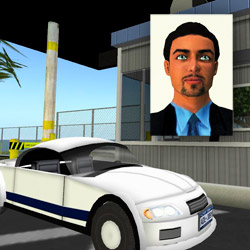
The car, a small white sports car with Minnesota plates, pulls up to Edward’s booth at the Canadian border crossing. Edward’s interaction with the driver is crisp and businesslike.
“What is the purpose of your trip?” he asks.
“Uh, I’m just planning to visit my aunt in Canada,” the driver replies.
“Do you have anything that you are planning to leave in the country?” Edward continues.
“Um, no,” answers the driver.
“How much wine, liquor or beer do you have?” asks Edward.
“I have one bottle of wine I plan to have with supper,” says the driver.
 This border crossing is typical, like thousands that happen every day—with one exception. Edward is not at the border, nor is the wine-loving driver of the white sports car. Edward is a student at Loyalist College in Belleville, Ontario. He is learning to staff a border crossing, and his booth is a three-dimensional replica created in the virtual world of Second Life. The actual Edward is sitting at a computer, wearing a headset and looking through a computer screen as virtual vehicles approach his booth. The drivers are played by faculty or other students.
This border crossing is typical, like thousands that happen every day—with one exception. Edward is not at the border, nor is the wine-loving driver of the white sports car. Edward is a student at Loyalist College in Belleville, Ontario. He is learning to staff a border crossing, and his booth is a three-dimensional replica created in the virtual world of Second Life. The actual Edward is sitting at a computer, wearing a headset and looking through a computer screen as virtual vehicles approach his booth. The drivers are played by faculty or other students.
This is just one of many examples illustrating a new trend in training—putting learners into a “virtual world” to learn real-world skills.
What Are Virtual Worlds And How Do They Work?
- Virtual worlds are online, three-dimensional environments.
- They may or may not be reproductions of real places.
- Users are represented by avatars—“cartoonish” versions of themselves that may or may not look anything like the user.
- Avatars move around, interact with each other and their environment, and communicate with other avatars via text or voice using VoIP (voice over internet protocol) and headsets.
- Virtual worlds look a lot like video games and can be used for gaming, but are different in that they tend to be open-ended without rules, scores or preset objectives.
- Many virtual worlds are user-created.
While most virtual worlds began their existence as social and game-oriented applications, they are being increasingly used to help organizations and corporations teach and train their workforces.
One excellent example of virtual world training is the disaster response simulator created by an organization called Play2Train using the Second Life virtual world. Recognizing that it would be impossible for a medical center to totally close down in order to rehearse their disaster response plan, Play2Train reproduced various elements of the center virtually, including the emergency room and parking areas. They then ran a simulated flu epidemic, with patients arriving via ambulance and being triaged in the parking lot, and hospital staff practicing their procedures and communication skills. While not every element of an actual emergency could be simulated, this type of immersive practice allowed staff to understand and appreciate their roles in a crisis, and motivated them to learn their procedures far better in order to be truly prepared for the real-life situation.
 Both this and the border crossing simulation were complex and expensive uses of virtual technology. Many businesses start much smaller. Simple role playing activities, such as sales training, can be conducted with a minimum of preparation, yet closely approximate face-to-face interactions. One sales training activity set in a virtual world was a simple role-play of a sales conversation. As the conversation proceeded, the trainer acting as the customer would place sales tips onto a spinning cube above his head. The sales trainee later reported that when he began working with actual customers, he would sometimes still see the spinning cube in his mind, reminding him to use the skills he had learned.
Both this and the border crossing simulation were complex and expensive uses of virtual technology. Many businesses start much smaller. Simple role playing activities, such as sales training, can be conducted with a minimum of preparation, yet closely approximate face-to-face interactions. One sales training activity set in a virtual world was a simple role-play of a sales conversation. As the conversation proceeded, the trainer acting as the customer would place sales tips onto a spinning cube above his head. The sales trainee later reported that when he began working with actual customers, he would sometimes still see the spinning cube in his mind, reminding him to use the skills he had learned.
What makes virtual world training worth the extra effort? In a recent book entitled Learning In 3D, authors Karl Kapp and Tony O’Driscoll summarize it with the formula I + I = E; Interaction + Immersion = Engagement. While many forms of online training suffer from participants’ tendency to multi-task or lose focus, well-designed virtual world training pulls the participant into the training and makes it memorable, practical and engaging.
Virtual World Training is the Best Solution When...
- You must do training online, but want it to be highly immersive and engaging.
- You have time and resources to set up a virtual learning environment and design learning experiences specifically for that environment.
- Elements of the training include movement and interaction with the environment and other individuals.
- You want the dynamics and connection that come with face-to-face training, without the travel time and expense.
- You can devote time to familiarizing participants with the virtual environment.
Virtual world-based training presents a lot of challenges, but as technology and computer capabilities continue to develop, it will become an increasingly useful tool in the area of employee learning and development. More importantly, it will allow companies to create and deliver exciting learning opportunities in which “anything is possible!” iBi
John Howard is a freelance trainer and virtual world producer based out
of Morton, Illinois. He has developed multiple projects and conferences in
virtual world settings, and is currently working on a project that uses virtual world technology to teach life skills to autistic teens in the New York City school system. You can reach him at jphoward7@gmail.com. His primary avatar is Corwin Howlett in Second Life.

